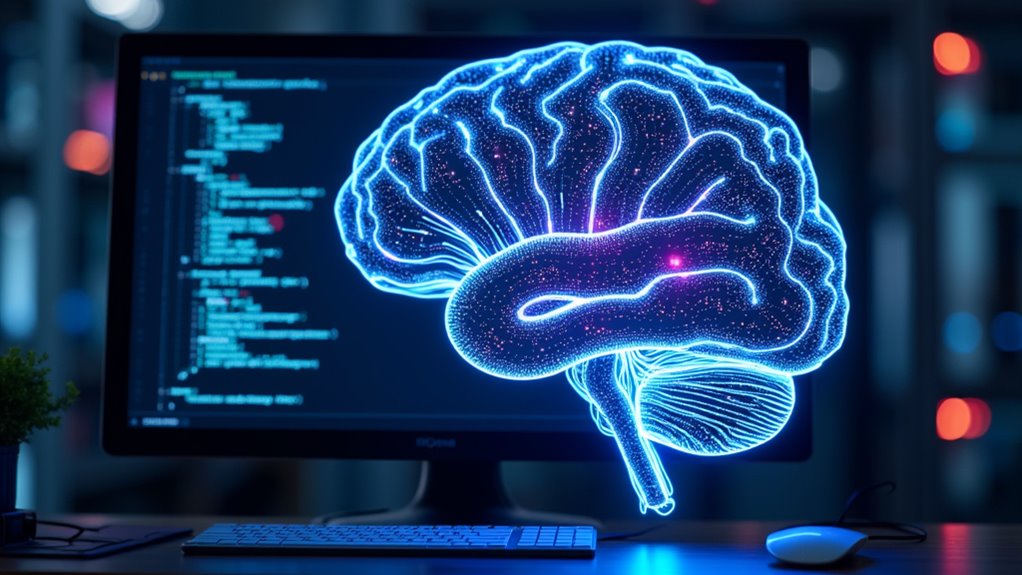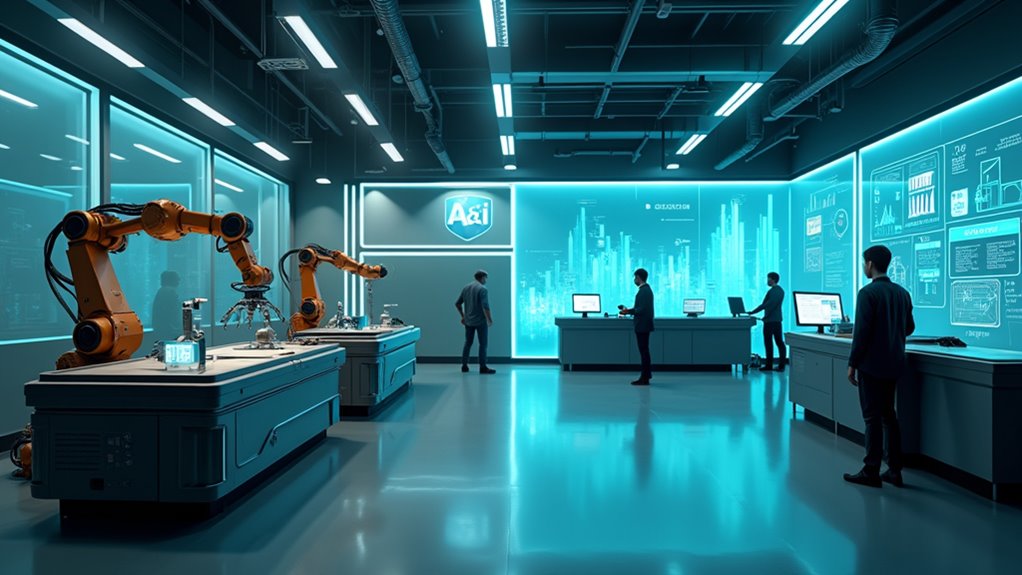Creating an AI program requires clear business goals first—not just chasing shiny tech trends. Start by defining your specific problem, then gather quality data (garbage in, garbage out!). Choose between pre-trained models or custom solutions based on your needs, not complexity for complexity’s sake. Train your model with proper data splits, deploy it thoughtfully, and monitor performance religiously. The difference between AI success and an expensive mistake lies in these essential foundations.

Creating an AI program isn’t just for tech wizards with multiple PhDs—anyone with determination and the right approach can build one. The journey begins with defining clear AI Program Goals that align with specific business needs. What problem are you trying to solve? Who benefits? Will customers actually care about your AI solution, or are you just chasing AI Technology Trends because they’re shiny?
Successful AI initiatives require rigorous stakeholder identification and honest technical feasibility assessment. Don’t skip the ethical impact evaluation—unless you enjoy PR nightmares and potential lawsuits!
Before diving into code, invest time understanding AI fundamentals. The difference between general AI (still science fiction) and narrow AI (what we actually build today) matters enormously. Machine learning concepts form the backbone of practical applications, whether you’re exploring natural language processing, computer vision, or predictive analytics. Each type of AI is designed for distinct use cases that require different development approaches. Think of data science as AI’s more practical cousin—they work together, but aren’t identical.
Data makes or breaks your AI program. Period. Identify quality data sources, then clean that data like your project’s life depends on it—because it does. Garbage in, garbage out isn’t just a cute saying; it’s the brutal reality of AI development. Split your data properly between training, validation, and testing sets, or prepare for spectacular failure later.
Selecting the right model architecture requires balancing complexity against your specific needs. Pre-trained models like GPT offer shortcuts, but custom solutions might better fit unique problems. Hyperparameter tuning sounds fancy but simply means tweaking settings until performance improves. During the model selection phase, carefully weigh factors like use case requirements, cost considerations, and data privacy regulations to ensure compliance and effectiveness.
Training your model requires patience and computational resources. Evaluate results using appropriate metrics—accuracy alone often misleads. Prevent overfitting through techniques like regularization and cross-validation. Implementing effective process automation can significantly reduce manual workloads and free up resources during the development lifecycle.
Finally, deployment isn’t an afterthought—it’s make-or-break. Choose between cloud, on-premises, or edge deployment based on practical considerations like latency requirements and data privacy. Integration with existing systems requires careful planning, testing, and monitoring to guarantee your AI doesn’t just work in theory but delivers actual business value.
Frequently Asked Questions
How Much Coding Experience Is Needed for AI Development?
AI development requires varying coding experience, depending on the role. Beginner requirements often include Python proficiency and understanding of basic algorithms.
Advanced AI requires deeper expertise in programming languages and frameworks like TensorFlow or PyTorch. Non-coders can start with no-code platforms but will eventually hit limitations.
The sweet spot? Solid programming fundamentals with specialization in AI-specific tools.
Don’t panic—start small and build your skills incrementally as you tackle more complex projects.
What’s the Cost of Building a Commercial AI Program?
Commercial AI program costs vary dramatically based on complexity.
Basic AI solutions might run $20,000-$80,000, while advanced systems can exceed $500,000.
Budget estimation should account for development resources including specialized talent (who aren’t cheap!), infrastructure, and data management.
Industry matters too—healthcare AI typically costs $300,000+, while retail solutions start around $200,000.
Want to save money? Consider pre-trained models or cloud services instead of building everything from scratch.
The ROI can justify the investment, though.
How Long Does AI Program Development Typically Take?
AI program development timelines vary dramatically based on project complexity.
Basic chatbots might take 3-6 months, while advanced systems like medical AI require 2+ years.
The development journey isn’t just coding—it’s data collection, model training, and endless testing.
Want to speed things up? Generative AI tools can slash development time by up to 50%.
Can AI Programs Run on Standard Consumer Hardware?
Yes, AI programs can run on standard consumer hardware, but with consumer hardware limitations.
Basic AI tasks work fine, while complex models struggle. AI performance optimization becomes essential—lightweight models and efficient coding help squeeze performance from average machines.
Most modern computers handle simple image generation and chatbots, but large language models? Not so much.
For serious AI work, dedicated GPUs (preferably NVIDIA) or cloud computing offer better alternatives than maxing out your poor laptop.
Are There Legal Considerations When Creating AI Programs?
Yes, legal considerations are essential when creating AI programs.
Intellectual property concerns loom large—who owns AI-generated content? Not as simple as you’d think!
Data privacy regulations like GDPR and CCPA demand strict compliance when handling personal information.
Don’t forget jurisdictional differences; what’s legal in one country might land you in hot water elsewhere.
Developers must navigate copyright issues for training data, transparency requirements, and potential liability concerns.
Ignore these, and you’re basically inviting lawyers to your doorstep.









